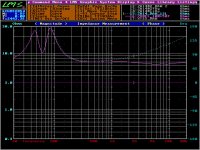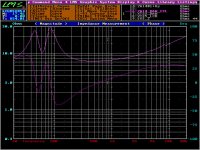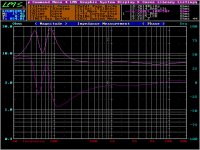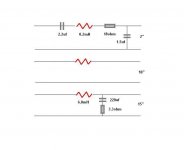BSC= Baffle step compensation. (keeps bass in balance with mids according to front baffle width of speaker box).
So RC= resistor chooses impedance, capacitor is in charge of what freq the resistor grabs hold of the signal and takes charge then?
I'm not an electronics engineer (obviously), so is this is what is happening in such a circuit (effectivly)?
Mick.
So RC= resistor chooses impedance, capacitor is in charge of what freq the resistor grabs hold of the signal and takes charge then?
I'm not an electronics engineer (obviously), so is this is what is happening in such a circuit (effectivly)?
Mick.
For a true Zobel, R will be roughly the DCR of the driver (plus a little fudge factor) and C = L/R2. If you think of the driver as a resistance in series with the voice coil inductance, a few minutes of sketching and running through the basic math will illuminate how the Zobel works.
Possibly. It may also just cause the frequency response through the crossover region to become rougher. Speaker CAD simulations are worthwhile to try, for education if nothing else.
Again logic tells me that the xo point would move down if its done in this order, but I don't know enough to figure this is the actual case.
Possibly. It may also just cause the frequency response through the crossover region to become rougher. Speaker CAD simulations are worthwhile to try, for education if nothing else.
Makes sense Tinitus,
'Bright' in this particular case is more inline with where the bass and highs 'appear', as in distance from listener, if that makes sense. Although the sound is still somewhat 'confused, ie, it seems to shout slightly at times, and is a little muddy around xo.
I hope that makes sense! (phase issue?)
Mick.
'Bright' in this particular case is more inline with where the bass and highs 'appear', as in distance from listener, if that makes sense. Although the sound is still somewhat 'confused, ie, it seems to shout slightly at times, and is a little muddy around xo.
I hope that makes sense! (phase issue?)
Mick.
thanx again SY,
Online zobel calcs tell me R=3.9 ohm, this driver is RE 3.1, there's the fudge, and that info takes me a little closer audio chocolate!🙂
Cheers, Mick.
Online zobel calcs tell me R=3.9 ohm, this driver is RE 3.1, there's the fudge, and that info takes me a little closer audio chocolate!🙂
Cheers, Mick.
A proper Zobel converts your woofer impedance to resistive. The importance of this is the accuracy of the crossover (electrical and acoustic) at the targeted corner frequency.
What is normally overlooked is what happens after the crossover frequencies. Without a zobel, the impedance rises with frequency. The result of this is the roll-off will not be as steep as expected. If you are crossing near the limits of your woofer, cone breakup may not be sufficiently suppressed. This is one of the causes of "Harshness". Often, the finger is pointed at the tweeter. Its actually the cone breakup that's buried in the tweeter region.
The plot below is a ZA14 loaded in a 13L BR. Blue plot is without zobel. Violet plot is with 10R + 5uF
What is normally overlooked is what happens after the crossover frequencies. Without a zobel, the impedance rises with frequency. The result of this is the roll-off will not be as steep as expected. If you are crossing near the limits of your woofer, cone breakup may not be sufficiently suppressed. This is one of the causes of "Harshness". Often, the finger is pointed at the tweeter. Its actually the cone breakup that's buried in the tweeter region.
The plot below is a ZA14 loaded in a 13L BR. Blue plot is without zobel. Violet plot is with 10R + 5uF
Attachments
Thanx For that info Michael, I see a little clearer now, hopefully I'll get to hear a little clearer!
A proper Zobel converts your woofer impedance to resistive. The importance of this is the accuracy of the crossover (electrical and acoustic) at the targeted corner frequency.
What is normally overlooked is what happens after the crossover frequencies. Without a zobel, the impedance rises with frequency. The result of this is the roll-off will not be as steep as expected. If you are crossing near the limits of your woofer, cone breakup may not be sufficiently suppressed. This is one of the causes of "Harshness". Often, the finger is pointed at the tweeter. Its actually the cone breakup that's buried in the tweeter region.
The plot below is a ZA14 loaded in a 13L BR. Blue plot is without zobel. Violet plot is with 10R + 5uF
Hello,
Is it possible to post the phase angle of both curves ..
regards,
Originally posted by prickears
I get much cleaner sound without a zobel, (lack of knowledge on the subject being the main problem here I think), but also increased listening fatigue, if that makes any sense whatsoever.
(midrange move to far back........not as forward sounding).....
'Bright' in this particular case is more inline with where the bass and highs 'appear', as in distance from listener, if that makes sense. Although the sound is still somewhat 'confused, ie, it seems to shout slightly at times, and is a little muddy around xo.
A Zobel network is not the solution. In an 8 inch + tweeter 2-way, you're asking a lot from both of them. The woofer must go high enough to reach the tweeter comfortably. At the same time, the tweeter must go low enough to meet the woofer.
I would say a crossover at 1K5 to 2K is about right for your Vifa P22. The problem is most tweeters will be very distressed when crossed this low. You may want to check out the Dayton RS28A. I don't have this tweeter but others have used it at 1K8-2K with satisfactory results.
The subject found it's own way here, and so it must be fair to ask.......
How, exactly does this phase thing work?
on a first order slope its 90, second 180, and so forth, that bit i get. I think.
How they relate to one another is still a bit sketchy with me. What does a zobel or bsc or what ever do to the phase in addition to the xo,
then more to the point, how does one align the drivers accordingly, mechanicly?
The electrical signal thing I get (I think), but where is the accoustic centre of a given diaphragm (driver) @ a given freq?
This bit loses me!
Electrically I have limited understanding (at best), physicaly, i'm comletely lost!
Ie. If one considers the electrical design into the xo then surely one must consider physical side equaly?
Thanx again, Mick!😕
How, exactly does this phase thing work?
on a first order slope its 90, second 180, and so forth, that bit i get. I think.
How they relate to one another is still a bit sketchy with me. What does a zobel or bsc or what ever do to the phase in addition to the xo,
then more to the point, how does one align the drivers accordingly, mechanicly?
The electrical signal thing I get (I think), but where is the accoustic centre of a given diaphragm (driver) @ a given freq?
This bit loses me!
Electrically I have limited understanding (at best), physicaly, i'm comletely lost!
Ie. If one considers the electrical design into the xo then surely one must consider physical side equaly?
Thanx again, Mick!😕
What you read on crossovers and calculations are all correct from a theoretical standpoint.
What are not stated explicitly are the assumptions that:
1) they are all based on pure resistive loads
2) they all share the same acoustic centers
The resistive load can be partly treated with a zobel network. The acoustic centers are where the real problems are. Unless all the frequencies emit from the same point, things like 1st order have no phase shift do not hold.
In a conventional 2-way, where a tweeter sits above a woofer, a 1st order HP+LP is only phase aligned electrically. Acoustically, it is not. This can easily be verified using acoustic gated measurements for the crossover. You will often find one side of the crossover sums while the other side cancels. This is due to the displacement of the acoustic centers of the woofer and the tweeter.
The same 1st order network, just an inductor and a capacitor, will give almost perfect summing in a true coaxial. That's why coaxes are called "Point Sources". While their acoustic centers may not be 100% aligned, they are still much, much closer than having a tweeter above. Some speakers like a Thiel 2-way (woofer + tweeter), is time aligned 1st order. Looks easy, 1st order, but very complicated.
What are not stated explicitly are the assumptions that:
1) they are all based on pure resistive loads
2) they all share the same acoustic centers
The resistive load can be partly treated with a zobel network. The acoustic centers are where the real problems are. Unless all the frequencies emit from the same point, things like 1st order have no phase shift do not hold.
In a conventional 2-way, where a tweeter sits above a woofer, a 1st order HP+LP is only phase aligned electrically. Acoustically, it is not. This can easily be verified using acoustic gated measurements for the crossover. You will often find one side of the crossover sums while the other side cancels. This is due to the displacement of the acoustic centers of the woofer and the tweeter.
The same 1st order network, just an inductor and a capacitor, will give almost perfect summing in a true coaxial. That's why coaxes are called "Point Sources". While their acoustic centers may not be 100% aligned, they are still much, much closer than having a tweeter above. Some speakers like a Thiel 2-way (woofer + tweeter), is time aligned 1st order. Looks easy, 1st order, but very complicated.
Thanx Michael,
That info gave me the 'footing' needed to do some homework.
As for the zobel, I've tried about 30-40 combo's, and I think i'm very close.
I've settled (at least for the time being), on R=3.9 ohms and C= 57uf, which was very close to the calcs predictions.
I did some small adjustments to the LP XO, then.............
BANG!! Sounds like a different driver and a different box, the whole image is as tight as my good wife's purse strings!
Success is a great feeling!
Thanx for all your help with this little issue guys!
Now, excuse me while I have a good old listening session!😎
Mick.😀
That info gave me the 'footing' needed to do some homework.
As for the zobel, I've tried about 30-40 combo's, and I think i'm very close.
I've settled (at least for the time being), on R=3.9 ohms and C= 57uf, which was very close to the calcs predictions.
I did some small adjustments to the LP XO, then.............
BANG!! Sounds like a different driver and a different box, the whole image is as tight as my good wife's purse strings!
Success is a great feeling!
Thanx for all your help with this little issue guys!
Now, excuse me while I have a good old listening session!😎
Mick.😀
Hi Mick, good to hear that you have had some success! I read something fairly recently about using CAD tools for optimising the crossover (might have been in Joe D'appolito's "Testing loudspeakers" can't quite remember) which basically talked about how the CAD software can use the drivers natural rising impedance to Optimise the target response using less parts than would normally be possible. This of course requires that you have measurement gear to get an impedance curve of your woofer in box, and the CAD software to model it!
I've been down a similar path with Zobels, though I didn't persist as long as it sounds like you have. I decided I didn't like the sound with them at all, in fact I decided I didn't like ANY crossover on my woofers at all (though that was just the prototype)... Something I hope to be playing with again before too long, damn weather... hasn't been conducive to doing the oiling of my veneer..
Happy New year BTW 🙂
Tony.
I've been down a similar path with Zobels, though I didn't persist as long as it sounds like you have. I decided I didn't like the sound with them at all, in fact I decided I didn't like ANY crossover on my woofers at all (though that was just the prototype)... Something I hope to be playing with again before too long, damn weather... hasn't been conducive to doing the oiling of my veneer..
Happy New year BTW 🙂
Tony.
G'day Tony,
Great to hear from you,
I wouldn't normally have that much time on my hands.
However I had a run in with my shearing handpiece and severed an artery and tendon in my wrist😱. So tweaking is something I have plenty of time for ATM!😎
I tried first to work with the woofers natural impedance curve, however as Michael Chua rightly pointed out, some harshness was evident, due to cone breakup.😉
Tinitus suggested ball park the zobel then tinker till its right, and so I did and BINGO!!😀
I don't think the p22wp is a good candidate for a XOless project.
The P22 and SEAS 27tff, are working together like old long lost mates, so i'm like a pig in poo ATM! (I had almost completely given up on the p22 as a two way). Glad I didn't!😉
Thanx again men, Mick.
Great to hear from you,
I wouldn't normally have that much time on my hands.
However I had a run in with my shearing handpiece and severed an artery and tendon in my wrist😱. So tweaking is something I have plenty of time for ATM!😎
I tried first to work with the woofers natural impedance curve, however as Michael Chua rightly pointed out, some harshness was evident, due to cone breakup.😉
Tinitus suggested ball park the zobel then tinker till its right, and so I did and BINGO!!😀
I don't think the p22wp is a good candidate for a XOless project.
The P22 and SEAS 27tff, are working together like old long lost mates, so i'm like a pig in poo ATM! (I had almost completely given up on the p22 as a two way). Glad I didn't!😉
Thanx again men, Mick.
However I had a run in with my shearing handpiece and severed an artery and tendon in my wrist😱. So tweaking is something I have plenty of time for ATM!😎
I don't think the p22wp is a good candidate for a XOless project.
The P22 and SEAS 27tff, are working together like old long lost mates, so i'm like a pig in poo ATM! (I had almost completely given up on the p22 as a two way). Glad I didn't!😉
Thanx again men, Mick.
Yikes that sounds very nasty!! severing arteries (or tendons) is never a good thing!
Apparently being able to run a woofer without a crossover is a pretty rare thing, whether I'll get away with it or not remains to be seen.
So I assume if you are doing a two way you have ditched the top half of the ferals and gone back to the original box? Good to hear that you have successfully made a big improvement 🙂 I sealed up one of the three ways the other day, though haven't done any tests yet to check if it has made any significant difference... have only watched telie so hard to tell.
Tony.
That's the one Tony, they don't look THAT feral anymore!🙂
Moondog was right about the strained sound of those mids, at first they sound good, but once fatigue sets in, it never goes away!
He may have had the same prob in the end, dunno.
Have you ever experienced this?
Thought i'd try to get the two way thing happening again, think I'd tried so hard to get them right, I started looking in the wrong places for the problems myself! You know how it gets sometimes, DIYers fatigue, or something!😉
Going to Bendigo tomorrow, so i'll drop into jaycar and grab a few values of inductors and caps that I haven't already got, will listen for a while then see if i can't improve them a little more.😉
As for the wrist (flexor carpal radialis tendon (very important for a shearer), and the artery you take your pulse from) I was under the knife crissy eve, and have already bounced back better than can be reasonably expected. Hope to be shearing again in 3-4 weeks but we'll see how we go with that one!
I needed an op for carpal tunnel syndrome anyway, (booked in for easter) done the op myself quicker than any surgeon!😀
Thanx M8, Mick!🙂
Moondog was right about the strained sound of those mids, at first they sound good, but once fatigue sets in, it never goes away!
He may have had the same prob in the end, dunno.
Have you ever experienced this?
Thought i'd try to get the two way thing happening again, think I'd tried so hard to get them right, I started looking in the wrong places for the problems myself! You know how it gets sometimes, DIYers fatigue, or something!😉
Going to Bendigo tomorrow, so i'll drop into jaycar and grab a few values of inductors and caps that I haven't already got, will listen for a while then see if i can't improve them a little more.😉
As for the wrist (flexor carpal radialis tendon (very important for a shearer), and the artery you take your pulse from) I was under the knife crissy eve, and have already bounced back better than can be reasonably expected. Hope to be shearing again in 3-4 weeks but we'll see how we go with that one!
I needed an op for carpal tunnel syndrome anyway, (booked in for easter) done the op myself quicker than any surgeon!😀
Thanx M8, Mick!🙂
Moondog was right about the strained sound of those mids, at first they sound good, but once fatigue sets in, it never goes away!
He may have had the same prob in the end, dunno.
Have you ever experienced this?
Probably yes... My mids would definitely be "strained" as would my woofers, probably the only thing that isn't is the tweeter... part of the reason I wanted to build some new speakers was that these ones just didn't do it for me any more...
My Mids have a resonant freq of 350Hz (they are also domes) and they are crossed at 500Hz (I think only 2nd order) (probably should be more like 1000Hz... the woofers are recommended for below 500Hz only. The three ways are fine for watching TV and movies, but I hardly ever listen to music on them these days, something I hope will change if I ever get these MTM's done 😉
Tony.
Hi, I tried a zobel on 10" midbass, as I usually do
A bit surpricingly the zobel worked the opposite of expected and resulted in the 10" playing far more high midrange
My ears certainly didnt like that at all
Well, it is a tricky dipole "design"
Its the first time I have experienced a driver works better without a zobel
A bit surpricingly the zobel worked the opposite of expected and resulted in the 10" playing far more high midrange
My ears certainly didnt like that at all
Well, it is a tricky dipole "design"
Its the first time I have experienced a driver works better without a zobel
Attachments
Midrange is SEAS MCA15RCY, tweeter is Monacor DT-254. Crossover frequencies are 500Hz, 4Khz pure 2nd order filters in this 3-way speaker.
I used for Zobel at the midrange 1,5ohm+10uF because people and speaker designers mostly used these values. Somebody used 1,8 ohm+9,2uF other used 1,2ohm+8,2uF or 1,5ohm+12uF.
But according to an online calculator need 7,2ohm+14uF.
My question why people not used values according to the suggested calculation? Other question with my values I cannot damage the midrange or the amplifier? Am I safety?
What exactly the R and C influence? Is it really better to keep the suggested values or not?
Thank you.
I used for Zobel at the midrange 1,5ohm+10uF because people and speaker designers mostly used these values. Somebody used 1,8 ohm+9,2uF other used 1,2ohm+8,2uF or 1,5ohm+12uF.
But according to an online calculator need 7,2ohm+14uF.
My question why people not used values according to the suggested calculation? Other question with my values I cannot damage the midrange or the amplifier? Am I safety?
What exactly the R and C influence? Is it really better to keep the suggested values or not?
Thank you.
- Home
- Loudspeakers
- Multi-Way
- zobel vs impedance curve



